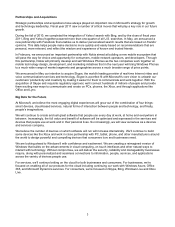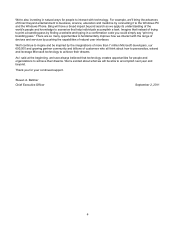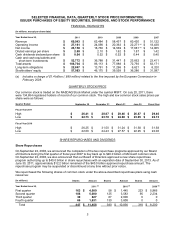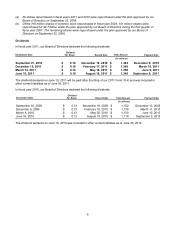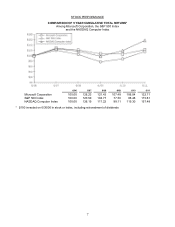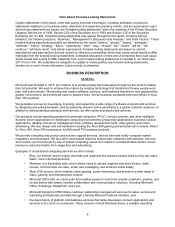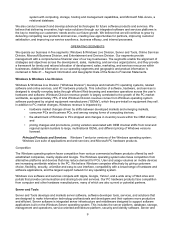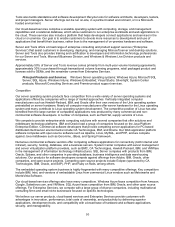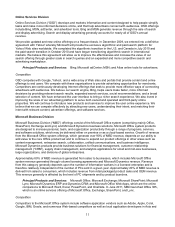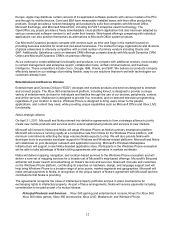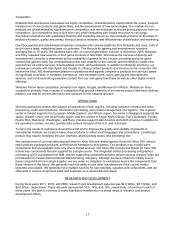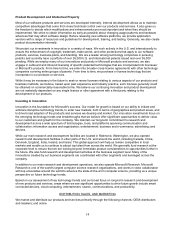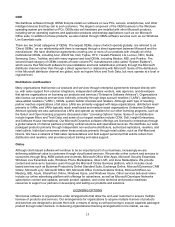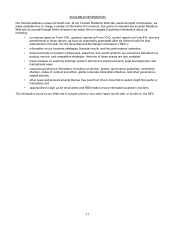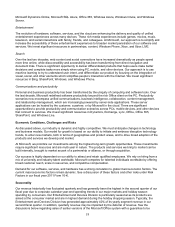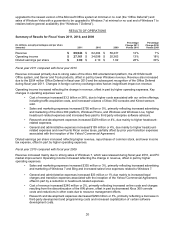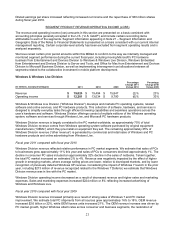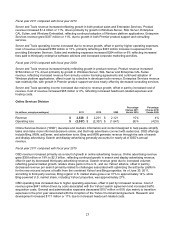Microsoft 2011 Annual Report Download - page 13
Download and view the complete annual report
Please find page 13 of the 2011 Microsoft annual report below. You can navigate through the pages in the report by either clicking on the pages listed below, or by using the keyword search tool below to find specific information within the annual report.
13
Competition
Entertainment and devices businesses are highly competitive, characterized by rapid product life cycles, frequent
introductions of new products and game titles, and the development of new technologies. The markets for our
products are characterized by significant price competition, and we anticipate continued pricing pressure from our
competitors. Our competitors vary in size from very small companies with limited resources to very large,
diversified corporations with substantial financial and marketing resources. We compete primarily on the basis of
product innovation, quality and variety, timing of product releases, and effectiveness of distribution and marketing.
Our Xbox gaming and entertainment business competes with console platforms from Nintendo and Sony, both of
which have a large, established base of customers. The lifecycle for gaming and entertainment consoles
averages five to 10 years. We released Xbox 360, our second generation console, in November 2005. Nintendo
and Sony released new versions of their game consoles in late 2006. We believe the success of gaming and
entertainment consoles is determined by the availability of games for the console, providing exclusive game
content that gamers seek, the computational power and reliability of the console, and the ability to create new
experiences via online services, downloadable content, and peripherals. In addition to Nintendo and Sony, our
businesses compete with both Apple and Google in offering content products and services to the consumer. We
believe the Xbox 360 entertainment platform is positioned well against competitive products and services based
on significant innovation in hardware architecture, new developer tools, online gaming and entertainment
services, and continued strong exclusive content from our own game franchises as well as other digital content
offerings.
Windows Phone faces competition primarily from Apple, Google, and Research In Motion. Mediaroom faces
competition primarily from a variety of competitors that provide elements of an Internet protocol television delivery
platform, but that do not provide end-to-end solutions for the network operator.
OPERATIONS
We have operations centers that support all operations in their regions, including customer contract and order
processing, credit and collections, information processing, and vendor management and logistics. The regional
center in Ireland supports the European, Middle Eastern, and African region; the center in Singapore supports the
Japan, Greater China, and Asia-Pacific region; and the centers in Fargo, North Dakota, Fort Lauderdale, Florida,
Puerto Rico, Redmond, Washington, and Reno, Nevada support Latin America and North America. In addition to
the operations centers, we also operate data centers throughout the U.S. and in Europe.
To serve the needs of customers around the world and to improve the quality and usability of products in
international markets, we localize many of our products to reflect local languages and conventions. Localizing a
product may require modifying the user interface, altering dialog boxes, and translating text.
We contract most of our manufacturing activities for Xbox 360 and related games, Kinect for Xbox 360, various
retail software packaged products, and Microsoft hardware to third parties. Our products may include some
components that are available from only one or limited sources. Our Xbox 360 console and Kinect for Xbox 360
include key components that are supplied by a single source. The integrated central processing unit/graphics
processing unit is purchased from IBM, and the supporting embedded dynamic random access memory chips are
purchased from Taiwan Semiconductor Manufacturing Company. Although we have chosen to initially source
these components from a single supplier, we are under no obligation to exclusively source the components from
these vendors in the future. We generally have the ability to use other manufacturers if the current vendor
becomes unavailable. We generally have multiple sources for raw materials, supplies, and components, and are
often able to acquire component parts and materials on a volume discount basis.
RESEARCH AND DEVELOPMENT
During fiscal years 2011, 2010, and 2009, research and development expense was $9.0 billion, $8.7 billion, and
$9.0 billion, respectively. These amounts represented 13%, 14%, and 15%, respectively, of revenue in each of
those years. We plan to continue to make significant investments in a broad range of research and product
development efforts.


